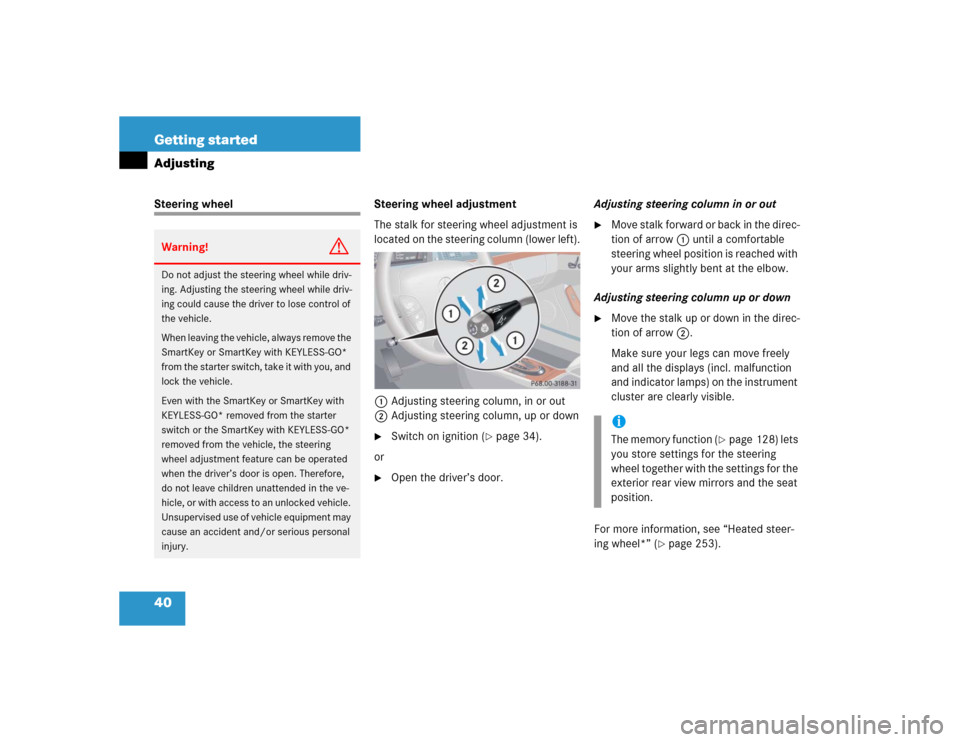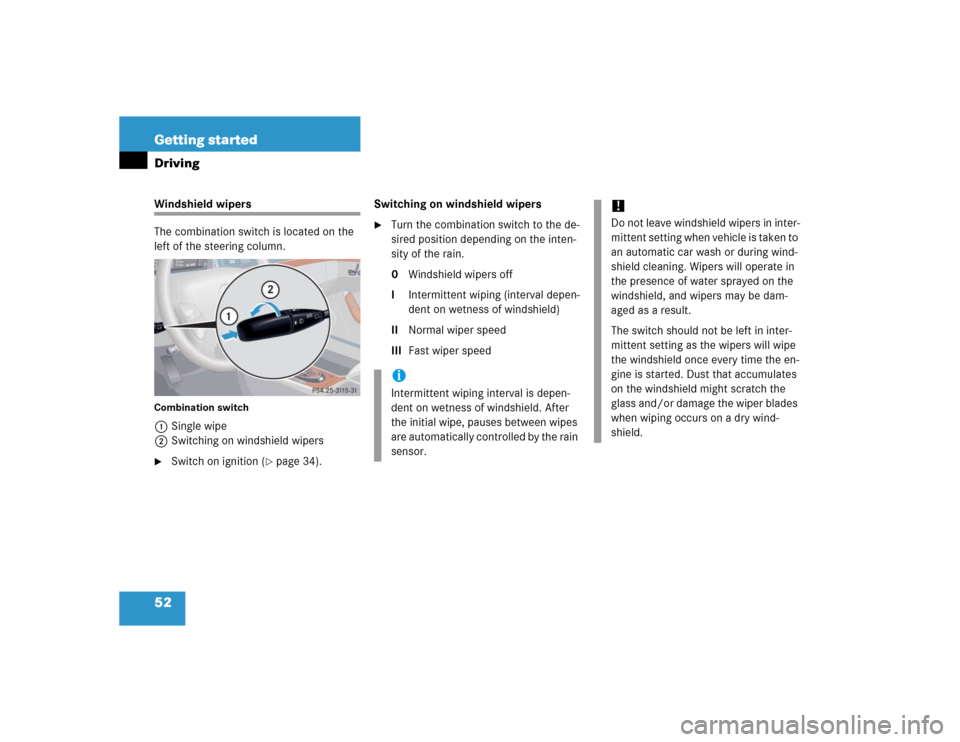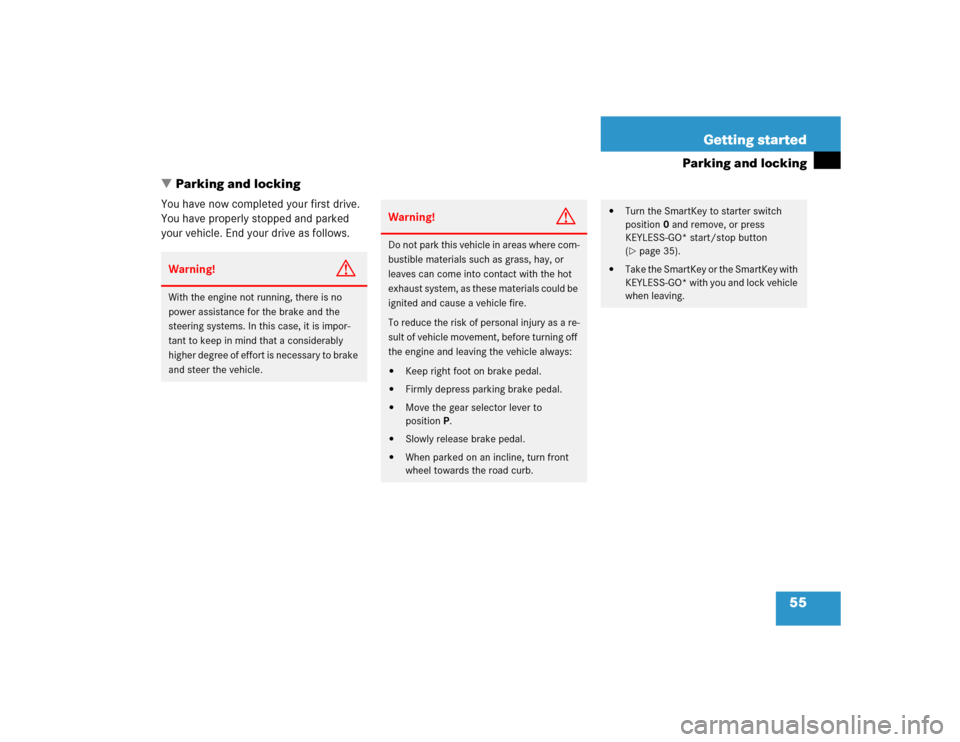Page 40 of 474

38 Getting startedAdjustingSeat adjustment
The seat adjustment switches are located
on the front doors.
1Head restraint height
2Seat height
3Seat cushion tilt
4Seat cushion depth
5Seat fore and aft adjustment
6Seat backrest tilt
�
Switch on ignition (
�page 34).
or
�
Open the respective door.
Seat fore and aft adjustment
�
Press the switch forward or backward
in the direction of arrow5.
Adjust seat to a comfortable seating
position that still allows you to reach
the accelerator/brake pedal safely.
The position should be as far to the rear
as possible, consistent with ability to
properly operate controls.Seat cushion tilt
�
Press the switch up or down in the di-
rection of arrow3until your upper
legs are lightly supported.
Seat cushion depth
�
Press the switch forward or backward
in the direction of arrow4 until your
legs are supported comfortably.
Seat backrest tilt
�
Press the switch forward or backward
in the direction of arrow6 until your
arms are slightly angled when holding
the steering wheel.
Seat height
�
Press the switch up or down in the di-
rection of arrow2.
A child’s risk of serious or fatal injuries is
significantly increased if the child restraints
are not properly secured in the vehicle and
the child is not properly secured in the child
restraint.
iWhen moving the seat, make sure
there are no items in the footwell or be-
hind the seats. Otherwise you could
damage the seats.
The memory function (
�page 128) lets
you store the setting for the seat posi-
tion together with the settings for the
steering wheel and the exterior rear
view mirrors.
��
Page 42 of 474

40 Getting startedAdjustingSteering wheel Steering wheel adjustment
The stalk for steering wheel adjustment is
located on the steering column (lower left).
1Adjusting steering column, in or out
2Adjusting steering column, up or down
�
Switch on ignition (
�page 34).
or
�
Open the driver’s door.Adjusting steering column in or out
�
Move stalk forward or back in the direc-
tion of arrow1 until a comfortable
steering wheel position is reached with
your arms slightly bent at the elbow.
Adjusting steering column up or down
�
Move the stalk up or down in the direc-
tion of arrow2.
Make sure your legs can move freely
and all the displays (incl. malfunction
and indicator lamps) on the instrument
cluster are clearly visible.
For more information, see “Heated steer-
ing wheel*” (
�page 253).
Warning!
G
Do not adjust the steering wheel while driv-
ing. Adjusting the steering wheel while driv-
ing could cause the driver to lose control of
the vehicle.
When leaving the vehicle, always remove the
SmartKey or SmartKey with KEYLESS-GO*
from the starter switch, take it with you, and
lock the vehicle.
Even with the SmartKey or SmartKey with
KEYLESS-GO* removed from the starter
switch or the SmartKey with KEYLESS-GO*
removed from the vehicle, the steering
wheel adjustment feature can be operated
when the driver’s door is open. Therefore,
do not leave children unattended in the ve-
hicle, or with access to an unlocked vehicle.
Unsupervised use of vehicle equipment may
cause an accident and/or serious personal
injury.
iThe memory function (
�page 128) lets
you store settings for the steering
wheel together with the settings for the
exterior rear view mirrors and the seat
position.
Page 44 of 474
42 Getting startedAdjustingThe buttons are located on the driver’s
door.
1 Driver’s side exterior rear view mirror
button
2Passenger-side exterior rear view mir-
ror button
3Adjustment button
�
Switch on ignition (
�page 34).
�
Press button1 for the left mirror or
button2 for the right mirror.
�
Push adjustment button3 up, down,
left, or right according to the desired
setting.
For more information, see “Folding exteri-
or rear view mirrors in and out
automatically” (
�page 188).
!For information on how to reposition
the exterior mirror housing when it was
forcibly pushed forward (hit from the
rear) or forcibly pushed rearward (hit
from the front), see “Folding exterior
rear view mirrors in and out manually”
(�page 189).
iThe memory function (
�page 128) lets
you store the setting for the exterior
rear view mirrors together with the set-
ting for the steering wheel and the seat
position.
At low ambient temperatures, the mir-
rors will be heated automatically.
Page 52 of 474
50 Getting startedDrivingSwitching on headlamps
Low beam headlamps
The exterior lamp switch is located on the
dashboard to the left of the steering wheel.Exterior lamp switch1Off
2Low beam headlamps on�
Turn the switch toB.
The green indicator lampC in the
exterior lamp switch comes on.
For more information, see “Exterior lamp
switch” (
�page 131).High beam
The combination switch is located on the
left of the steering column.
Combination switch1High beam
2High beam flasher
�
Push combination switch in direction of
arrow1.
The high beam headlamps are switched
on.
The high beam headlamp
indicatorA in the tachometer
comes on.
For more information, see “Lighting”
(
�page 131).
Page 53 of 474
51 Getting started
Driving
Turn signals
The combination switch is located on the
left of the steering column.Combination switch1Turn signals, right
2Turn signals, left
�
Press the combination switch up1 or
down2.
The corresponding turn signal indicator
lampL orK flashes in the in-
strument cluster (
�page 24).The combination switch resets automati-
cally after major steering wheel move-
ments.
iTo signal minor directional changes,
e.g. passing or changing lanes, move
combination switch to point of resis-
tance only and release. The turn signal
flashes three times.
Page 54 of 474

52 Getting startedDrivingWindshield wipers
The combination switch is located on the
left of the steering column.Combination switch1Single wipe
2Switching on windshield wipers�
Switch on ignition (
�page 34).Switching on windshield wipers
�
Turn the combination switch to the de-
sired position depending on the inten-
sity of the rain.
0Windshield wipers off
IIntermittent wiping (interval depen-
dent on wetness of windshield)
IINormal wiper speed
IIIFast wiper speediIntermittent wiping interval is depen-
dent on wetness of windshield. After
the initial wipe, pauses between wipes
are automatically controlled by the rain
sensor.
!Do not leave windshield wipers in inter-
mittent setting when vehicle is taken to
an automatic car wash or during wind-
shield cleaning. Wipers will operate in
the presence of water sprayed on the
windshield, and wipers may be dam-
aged as a result.
The switch should not be left in inter-
mittent setting as the wipers will wipe
the windshield once every time the en-
gine is started. Dust that accumulates
on the windshield might scratch the
glass and/or damage the wiper blades
when wiping occurs on a dry wind-
shield.
Page 57 of 474

55 Getting started
Parking and locking
�Parking and locking
You have now completed your first drive.
You have properly stopped and parked
your vehicle. End your drive as follows.Warning!
G
With the engine not running, there is no
power assistance for the brake and the
steering systems. In this case, it is impor-
tant to keep in mind that a considerably
h i g h e r d e g r e e o f e f f o r t i s n e c e s s a r y t o b r a k e
and steer the vehicle.
Warning!
G
Do not park this vehicle in areas where com-
bustible materials such as grass, hay, or
leaves can come into contact with the hot
exhaust system, as these materials could be
ignited and cause a vehicle fire.
To reduce the risk of personal injury as a re-
sult of vehicle movement, before turning off
the engine and leaving the vehicle always:�
Keep right foot on brake pedal.
�
Firmly depress parking brake pedal.
�
Move the gear selector lever to
positionP.
�
Slowly release brake pedal.
�
When parked on an incline, turn front
wheel towards the road curb.
�
Turn the SmartKey to starter switch
position0 and remove, or press
KEYLESS-GO* start/stop button
(�page 35).
�
Take the SmartKey or the SmartKey with
KEYLESS-GO* with you and lock vehicle
when leaving.
Page 63 of 474

61 Safety and Security
Occupant safety
Air bags
Warning!
G
In the event that the 1 indicator lamp
comes on during driving or does not come
on at all, the SRS self-check has detected a
malfunction. For your safety, we strongly
recommend that you visit an authorized
Mercedes-Benz Center immediately to have
the system checked; otherwise the SRS may
not be activated when needed in an acci-
dent, which could result in serious or fatal
injury, or it might deploy unexpectedly and
unnecessarily which could also result in
injury.
In addition, improper repair work on the SRS
creates a risk of rendering the SRS inopera-
tive or causing unintended air bag deploy-
ment. Work on the SRS must therefore only
be performed by qualified technicians. Con-
tact an authorized Mercedes-Benz Center.
Warning!
G
Air bags are designed to reduce the poten-
tial of injury and fatality in certain frontal im-
pacts (front air bags), side impacts (side
impact air bags and head protection window
curtain air bags) or rollovers (head protec-
tion window curtain air bags). However, no
system available today can totally eliminate
injuries and fatalities.
The activation of the air bags temporarily re-
leases a small amount of dust from the
air bags. This dust, however, is neither inju-
rious to your health, nor does it indicate a
fire in the vehicle. The dust might cause
some temporary breathing difficulty for peo-
ple with asthma or other breathing trouble.
To avoid this, you may wish to get out of the
vehicle as soon as it is safe to do so. If you
have any breathing difficulty but cannot get
out of the vehicle after the air bag inflates,
then get fresh air by opening a window or
door.
Warning!
G
To reduce the risk of injury when the front
air bags inflate, it is very important for the
driver and passenger front to always be in a
properly seated position and to wear your
seat belts.
For maximum protection in the event of a
collision always be in normal seated position
with your back against the seat backrest.
Fasten your seat belt and make sure it is
properly positioned on your body.
Since the air bag inflates with considerable
speed and force, a proper seating and hands
on steering wheel position will help to keep
you at a safe distance from the air bag. Oc-
cupants who are unbelted, out of position or
too close to the air bag can be seriously in-
jured by an air bag as it inflates with great
force in the blink of an eye:�
Sit properly belted in a nearly upright
position with your back against the seat
backrest.
��